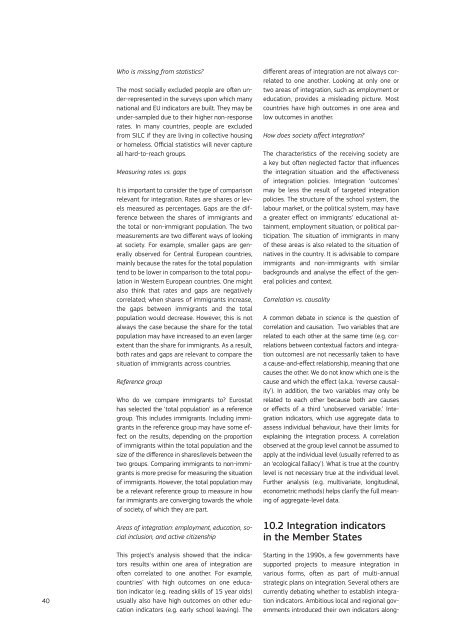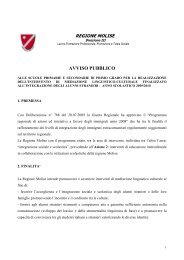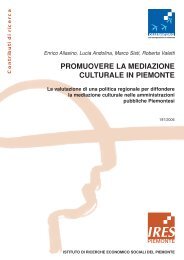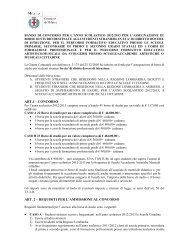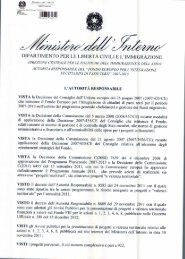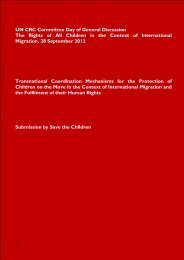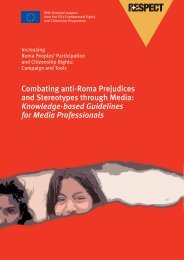Using EU Indicators of Immigrant Integration - European ...
Using EU Indicators of Immigrant Integration - European ...
Using EU Indicators of Immigrant Integration - European ...
- No tags were found...
Create successful ePaper yourself
Turn your PDF publications into a flip-book with our unique Google optimized e-Paper software.
40Who is missing from statistics?The most socially excluded people are <strong>of</strong>ten under-representedin the surveys upon which manynational and <strong>EU</strong> indicators are built. They may beunder-sampled due to their higher non-responserates. In many countries, people are excludedfrom SILC if they are living in collective housingor homeless. Official statistics will never captureall hard-to-reach groups.Measuring rates vs. gapsIt is important to consider the type <strong>of</strong> comparisonrelevant for integration. Rates are shares or levelsmeasured as percentages. Gaps are the differencebetween the shares <strong>of</strong> immigrants andthe total or non-immigrant population. The twomeasurements are two different ways <strong>of</strong> lookingat society. For example, smaller gaps are generallyobserved for Central <strong>European</strong> countries,mainly because the rates for the total populationtend to be lower in comparison to the total populationin Western <strong>European</strong> countries. One mightalso think that rates and gaps are negativelycorrelated; when shares <strong>of</strong> immigrants increase,the gaps between immigrants and the totalpopulation would decrease. However, this is notalways the case because the share for the totalpopulation may have increased to an even largerextent than the share for immigrants. As a result,both rates and gaps are relevant to compare thesituation <strong>of</strong> immigrants across countries.Reference groupWho do we compare immigrants to? Eurostathas selected the ‘total population’ as a referencegroup. This includes immigrants. Including immigrantsin the reference group may have some effecton the results, depending on the proportion<strong>of</strong> immigrants within the total population and thesize <strong>of</strong> the difference in shares/levels between thetwo groups. Comparing immigrants to non-immigrantsis more precise for measuring the situation<strong>of</strong> immigrants. However, the total population maybe a relevant reference group to measure in howfar immigrants are converging towards the whole<strong>of</strong> society, <strong>of</strong> which they are part.Areas <strong>of</strong> integration: employment, education, socialinclusion, and active citizenshipThis project’s analysis showed that the indicatorsresults within one area <strong>of</strong> integration are<strong>of</strong>ten correlated to one another. For example,countries’ with high outcomes on one educationindicator (e.g. reading skills <strong>of</strong> 15 year olds)usually also have high outcomes on other educationindicators (e.g. early school leaving). Thedifferent areas <strong>of</strong> integration are not always correlatedto one another. Looking at only one ortwo areas <strong>of</strong> integration, such as employment oreducation, provides a misleading picture. Mostcountries have high outcomes in one area andlow outcomes in another.How does society affect integration?The characteristics <strong>of</strong> the receiving society area key but <strong>of</strong>ten neglected factor that influencesthe integration situation and the effectiveness<strong>of</strong> integration policies. <strong>Integration</strong> ‘outcomes’may be less the result <strong>of</strong> targeted integrationpolicies. The structure <strong>of</strong> the school system, thelabour market, or the political system, may havea greater effect on immigrants’ educational attainment,employment situation, or political participation.The situation <strong>of</strong> immigrants in many<strong>of</strong> these areas is also related to the situation <strong>of</strong>natives in the country. It is advisable to compareimmigrants and non-immigrants with similarbackgrounds and analyse the effect <strong>of</strong> the generalpolicies and context.Correlation vs. causalityA common debate in science is the question <strong>of</strong>correlation and causation. Two variables that arerelated to each other at the same time (e.g. correlationsbetween contextual factors and integrationoutcomes) are not necessarily taken to havea cause-and-effect relationship, meaning that onecauses the other. We do not know which one is thecause and which the effect (a.k.a. ‘reverse causality’).In addition, the two variables may only berelated to each other because both are causesor effects <strong>of</strong> a third ‘unobserved variable.’ <strong>Integration</strong>indicators, which use aggregate data toassess individual behaviour, have their limits forexplaining the integration process. A correlationobserved at the group level cannot be assumed toapply at the individual level (usually referred to asan ‘ecological fallacy’). What is true at the countrylevel is not necessary true at the individual level.Further analysis (e.g. multivariate, longitudinal,econometric methods) helps clarify the full meaning<strong>of</strong> aggregate-level data.10.2 <strong>Integration</strong> indicatorsin the Member StatesStarting in the 1990s, a few governments havesupported projects to measure integration invarious forms, <strong>of</strong>ten as part <strong>of</strong> multi-annualstrategic plans on integration. Several others arecurrently debating whether to establish integrationindicators. Ambitious local and regional governmentsintroduced their own indicators along-


